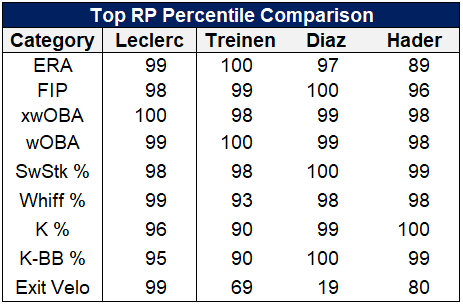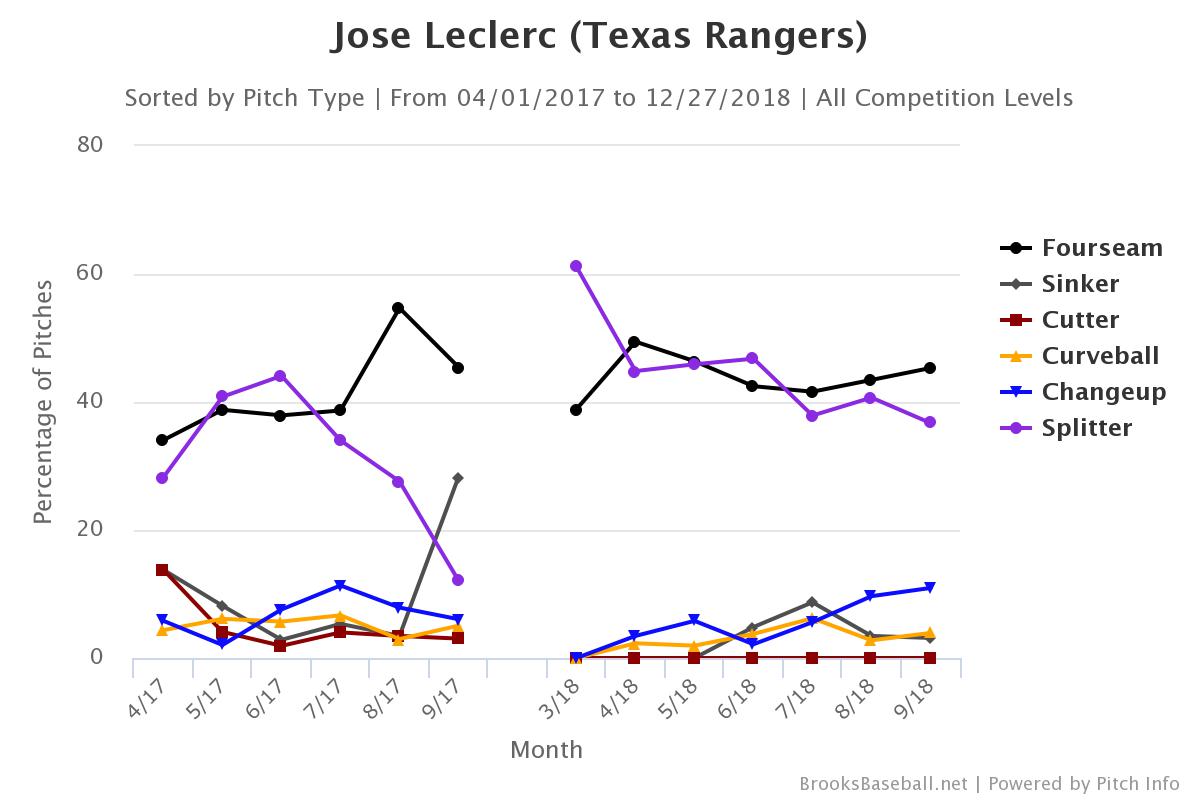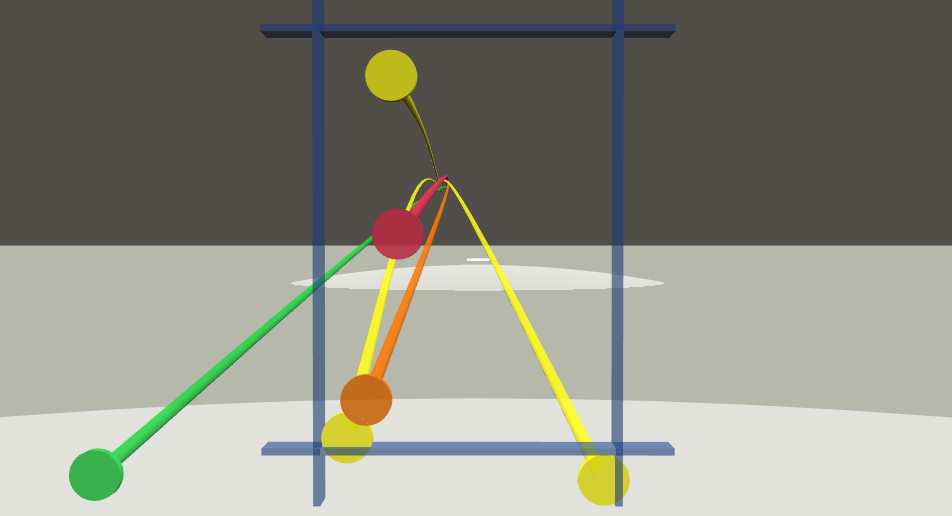While you might think the title reeks of clickbait, there is a legitimate reason to believe that Jose Leclerc, Texas’ 25-year-old righty out of the bullpen who was just signed to a well-deserved four-year, $14.75 million contract extension, is the best relief pitcher in baseball.
Leclerc posted one of MLB’s most dominant relief seasons last year, pitching to a sterling 1.56 ERA—third-best among relievers—and racking up fourth-highest fWAR of any bullpen arm, exceeded only by Blake Treinen, Edwin Diaz, and Josh Hader. Leclerc also finished in the top 10 in both strikeout rate and swinging-strike rate, adding a degree of legitimacy to the performance.
Yet few seem to have noticed that Leclerc pitched like vintage Craig Kimbrel last season. Fantrax’s preseason reliever rankings had Leclerc at a lowly 15th, putting him behind the likes of Raisel Iglesias and Wade Davis, while Leclerc’s current fantasy ADP is hovering in the 120 range, according to FantasyPros, with name-brand relievers going off the board 60 picks earlier.
The skepticism surrounding Leclerc likely results from the exorbitant walk rates he posted across the minors and his first two MLB seasons. Unfortunately, once a young player develops a reputation, it’s difficult to change it. But Leclerc largely remedied the walk issues in 2018, halving his free-pass tendencies from the previous year and finishing with a lower BB/9 than the likes of Kimbrel and Adam Ottavino.
The improvements in walk rate combined with the across-the-board statistical dominance exhibited by Leclerc indicates he’s potentially the best relief pitcher in baseball.
Statistical Dominance
Leclerc pitched a mere 57.2 innings last year—the low total a result infrequent early-season use capped with a demotion in the minors in April. Since relief pitchers only throw about one-third of the innings of a starter in a given season, there is a lot more room for luck to rear its head in a strongly positive or negative fashion. How can we be so sure that Leclerc’s 2018 wasn’t a small-sample aberration?
In last month’s article on German Marquez, I highlighted the importance of considering order of magnitude when evaluating small-sample statistical performance. The idea is that while we can’t necessarily put much stock in the repeatability of a player being “good” over 60 innings, we can start to develop more confidence in their performance baseline if they’re “excellent” in that short amount of time.
And boy was Leclerc excellent in 2018. Name the stat—WAR, ERA, FIP, xwOBA, wOBA, K%, SwStk%, Whiff %, Exit Velo—and he was among the game’s best.
Baseball Savant’s xwOBA, an all-inclusive statistic that measures pitcher performance based on strikeouts, walks, exit velocity and launch angle, thought Leclerc was the best reliever in baseball last year. Outside of the nearby Diaz, it wasn’t particularly close either, with the fifth-place Ottavino garnering an xwOBA 20 points higher than Leclerc’s microscopic .210.
Leclerc’s xwOBA dominance was backed up by a second-place showing in whiff rate, measured as swings and misses divided by swings, second only to Philadelphia’s Hector Neris. Leclerc’s 41.1% whiff rate outpaced names like Kimbrel, Diaz, Hader, Dellin Betances, and Aroldis Chapman, which is a testament to just how dominant his stuff is.
Some pitchers manage to induce a significant amount of whiffs but tend to get hit hard, which reduces their overall effectiveness. The aforementioned Neris is a perfect example, as the positive impact from his sky-high strikeout and whiff rates is tempered by an ugly 11.8% barrel rate and 88.3 mph average exit velocity. Hader is another pitcher that fits this mold, with a 10.6% barrel rate that results in a proclivity to give up home runs. Fortunately, Leclerc is a true double threat, combining an upper-echelon whiff rate with the second-lowest average exit velocity of any reliever in baseball.
The suppression of batted-ball velocity allowed Leclerc to allow only one home run in 2018, a 421-foot opposite-field blast to Oakland slugger Khris Davis. Some might view that type of performance as fluky—pitchers surely must give up more than one home run in 57.2 innings in this day and age, right? Maybe not. Leclerc’s average distance allowed on balls in the air was 254 feet, which ranked seventh-lowest out of 227 qualified relievers. In fact, Leclerc only allowed 12 balls to travel more than 330 feet last season. Only three balls went further than 360 feet. While it’s likely that Leclerc allows a few more home runs in 2019, he seems to have the profile of a consistent home run suppressor.
Leclerc exhibited across-the-board dominance in 2018. He sat in the 95th percentile or higher in every relevant pitching metric among relief pitchers, ranging from more traditional stats like ERA and strikeout rate to more refined ones like xwOBA and swinging-strike rate. The scale and scope of this performance was largely unrivaled last year, matched only by names like Treinen, Diaz, and Hader. However, even those pitchers failed to produce the same kind of exit-velocity suppression that Leclerc managed. While it was only 57.2 innings, the order of magnitude of Leclerc’s accomplishments should engender confidence that he’s the real deal and potentially the best relief pitcher in the game.
Mental Adjustments
But Leclerc wasn’t always this good. Despite possessing electric stuff, he was wild in the minors and through his first MLB cup of coffee in 2016 and full season in 2017. These tendencies led to an unsightly 7.9 BB/9 walk rate over his first two seasons, a level far too high for sustainable long-term success, even though he was able to stay afloat with a mid-3.00s ERA over his first two seasons.
Leclerc’s walk rate improved to 11.2% in 2018 and shrunk even further as the season progressed, clocking in at 9.0% from late May onward. Meanwhile, Leclerc’s K/9 spiked from an excellent 11.8 in 2017 to an upper-echelon 13.3 last season, with the resulting 26.9% K-BB rate serving as a high watermark for nearly any pitcher, starter or reliever.
Many times there is a specific change in a pitcher’s arsenal or mechanics that prompts such an abrupt improvement; however, in Leclerc’s case, conquering the mental aspect of the game seems to have been of paramount importance.
In a late-August interview with the Star-Telegram, Leclerc stated: “I think that’s the key from last year. I threw the fastball and I didn’t know where I was throwing it, and the other pitch was crazy. If I can’t throw the fastball for a strike, they’re not going to swing at the off-speed. I think everything came together. I don’t know what I’m doing different [mechanically] this year. I saw video, and everything’s the same.”
Leclerc’s lack of confidence was evident in the variability of his pitch mix from month to month in 2017. He started the season by throwing roughly an even mix (40% / 40%) of four-seam fastballs and what Brooks Baseball terms as a splitter; however, by August he dramatically ramped his four-seam usage and cut back significantly on the splitter. This trend continued in September, as he started throwing his sinker more often and scaled back the splitter to roughly 15% usage.
The splitter, an amorphous pitch that has also been called a slider by Baseball Savant and a cut changeup by Leclerc’s coaches, is Leclerc’s bread-and-butter offering. He produced an absurd 50.5% whiff rate and .163 xwOBA on the pitch in 2017, indicating that he probably shouldn’t have scaled back its use late in the season.
Leclerc’s pitch mix became much more stable in 2018, indicative of a pitcher growing into his skin and becoming more confident with his offerings. The four-seamer and splitter stabilized back at a roughly 40%/40% mix, complemented by infrequent usage of his secondary changeup and curveball. The splitter also became even more dominant in 2018, posting a scorching 56.1% whiff rate and .153 xwOBA. Leclerc’s four-seam fastball is also an underrated pitch, typically sitting at 95-96 mph and earning a 30.0% whiff rate over the last two years—the same level as Chris Sale and Max Scherzer.
Plan of Attack
Generally, standout relievers only need one upper-tier pitch to be successful. However, Leclerc has two, in his four-seamer and splitter. And while they are strong in isolation, they also work together to create a product that exceeds the sum of its parts.
Leclerc is comfortable enough to use both in any count, but he generally favors the fastball early on. He will then ramp his splitter usage with two strikes for the knockout punch. This tactic is evident in an August 17 matchup against the Angels’ Eric Young Jr., with Leclerc leading off the at-bat with a strong 96-mph four-seamer for a called strike on the outer half of the plate.
https://gfycat.com/UnlinedSoupyAfghanhound
While Leclerc caught a bit too much of the plate with the pitch, it’s a fine offering on an 0-0 count to get ahead. Young would have been unlikely to do much with the pitch even if he did swing. From there Leclerc turned to his splitter, painting the low outside corner with Michelangelo-like precision.
https://gfycat.com/GlumTautIndusriverdolphin
What could Young do with this pitch other than watch it sail by helplessly for another called strike? With its strong movement and perfect location, there are very few hitters who could have done anything except stare blankly at this one.
Leclerc’s third offering of the at-bat was a changeup that missed well out of the zone away, bringing the count to 1-2. He then went back to the fastball on the fourth pitch, earning a foul ball on a 97 mph heater low and away.
https://gfycat.com/CautiousAdeptHyracotherium
While most Pitcher List writers, myself included, preach the value of the elevated fastball with two strikes, Leclerc does well to place a high-velocity pitch in an area of the zone where Young has to swing but is unlikely to inflict any damage. The pitch registered as a two-seamer on Baseball Savant.
With the count at 1-2 still, Leclerc moves in for the kill on the fifth pitch, dotting an 83 mph splitter with massive break just below the lower inside corner. This was a strong pitch, and Young had to exercise significant forearm strength to check his swing and avoid the strikeout.
https://gfycat.com/AffectionateThankfulCollie
The back-and-forth play between Leclerc’s fastball and splitter must be extremely frustrating for hitters to manage, especially when the pitches are well-located. The below pitch map from the Young at-bat, with the red and orange dots as fastballs and yellow as splitters, highlights this reality. Leclerc primed Young to expect significant velocity on the middle to the outer half of the plate and then pulled the rug out from under him 35 feet from home with the significant break of the splitter.
Leclerc ended the at-bat in a fairly unconventional yet devastating manner, placing a splitter at the very top of the strike zone that Young whiffed on with a pool-noodle hack. Normally, breaking balls shouldn’t sit in the upper part of the zone this late in the count, but Leclerc was in complete control here, keeping the pitch out of the strike zone until the last second when it dove down to just nick the threshold of the upper zone.
https://gfycat.com/EarnestAdmirableCottontail
My favorite thing about this pitch is just how off-balance Young looks. Take a look at the pitter-patter of his feet. He was definitely expecting a fastball and had no clue what to do with a splitter that hit the top of the zone. The swing was an exercise in futility but a necessary evil, since keeping the bat on the shoulder for a called strike three looks even worse.
Leclerc is very liquid with his pitching approach, capable of throwing fastballs and splitters in every part of the zone for strikes. This likely keeps hitters very off-balance and is why he’s able to achieve such premium results in run prevention, whiff rates, and exit-velocity suppression. Let’s hope he can build on his success in 2018 and firmly establish himself as baseball’s best reliever.
Graphic by Nathan Mills (@NathanMillsPL on Twitter)





He could also revert to having putrid command. Many RP have put a single magic season together – it happens every year lots of times. You could write an entire article about recent history of TEX closers that never panned out. Remember Matt Bush – the fangraphs community was all-in. How about Jeffress and his magic season he pulled after leaving? Sam Dyson was relevant for a while. Paying for the breakout RP is always a bad bet. I don’t have an actual opinion on whether he is the real deal or not, but I am certain that he isn’t baseball’s best. Success always comes easiest the first time and there are so many reasons that RP stats don’t mean a whole lot.
I wouldn’t get too excited about how off balance a guy that can’t hit enough for an MLB job looks – EY Jr does that for everyone haha. I don’t think any pitcher ever intentionally spots a splitter up in the zone – it is almost surely a missed location. See how me missed the glove my over a foot? The catcher was setup low and in and the pitch was up and away – you really can’t miss by more and luck into a strike. That pitch is a good illustration of the disconnect between paper and reality. On paper (or Statcast) that is a great pitch, but in reality it was all luck and very little execution. Speaking of lucky misses, that first pitch was a terrible location – he was lucky EY was taking a strike – maybe he was just lucky it was EY. If he was facing Acuna, or someone who likes to swing at the first pitch that would have been the best HR pitch you could ask for. In any case he missed by close to a foot in a very bad way. On a positive, splitters are a good pitch to have – they let you get away with poor FB locations as they come out of the hand really similarly. The downside, is that they are kind of like a knuckle ball in that they are hard to control and the feel varies from day to day.
You make valid points. One thing to consider is non of the pitchers you mentioned have the kind of swing and miss that Leclerc has demonstrated. There is a reason why guys like Edwin Diaz, Betances and Jansen stand out as RP over time, and missing bats at a high rate consistently is a big reason.